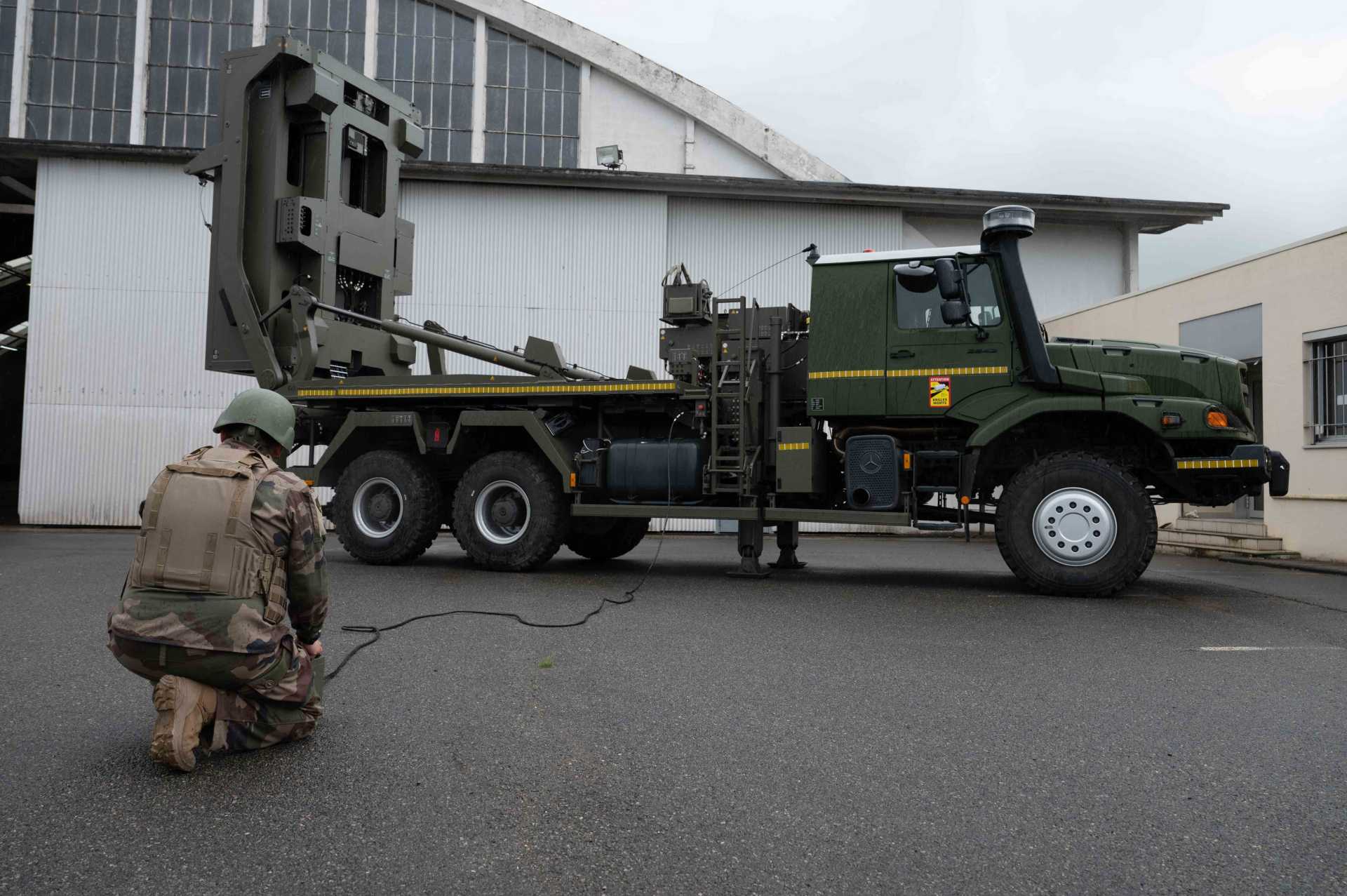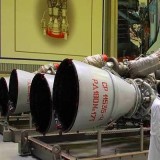New VL MICA Missile System in Focus as French Air Force Tests Airspace Protection During ASTER25

{loadposition bannertop}
{loadposition sidebarpub}
From April 22 to April 29, 2025, the French Air and Space Force is conducting ASTER25, a major air defense training exercise hosted by Air Base 702 Avord, with the VL MICA air defense missile system playing a central role in strengthening airspace protection capabilities. Located in the communes of Farges-en-Septaine and Avord, near Bourges and Baugy in the Cher department, Air Base 702 Avord — officially known as “Capitaine Georges Madon” Air Base — is the second-largest airbase in France after Air Base 125 Istres-Le Tubé. Follow Army Recognition on Google News at this link
French Air and Space Force soldiers deploy the VL MICA air defense missile system during the ASTER25 exercise at Air Base 702 Avord. (Picture source: French Air Force)
As a key installation of the French Air Force, it includes a military school, a ground-based air defense squadron, a maintenance and specialized equipment repair group, and, since 1991, an airborne detection unit equipped with AWACS radar aircraft that ensure territorial surveillance. It is also one of France’s most significant nuclear military bases, further emphasizing its strategic importance.
This year, ASTER25 focuses on the mission known as the “Dispositif Particulier de Sûreté Aérienne” (DPSA), a critical airspace security operation designed to protect national territory during sensitive events and in periods of heightened threat. The goal of the exercise is to perfect operational reflexes and strengthen the capabilities of air defense forces in detecting, analyzing, and responding to simulated aerial threats.
All ground-based air defense squadrons of the French Air and Space Force have been mobilized for this event. Operators from major bases such as Saint-Dizier, Istres, Avord, and Mont-de-Marsan are brought together at Avord to participate. Working in unison, they will safeguard the airspace by detecting, tracking, and neutralizing any simulated threats from the sky, ensuring a robust and highly coordinated defense network.
A major highlight of ASTER25 is the operational showcase of the new VL MICA air defense missile system. Recently integrated into the French Air and Space Force, the VL MICA system represents a significant leap forward in short- and medium-range ground-based air defense capabilities. It provides enhanced mobility, faster reaction times, and precision engagement against a wide range of aerial targets, including fast jets, helicopters, drones, and cruise missiles. The introduction of the VL MICA during this exercise demonstrates the modernization efforts of the French Air Force and its commitment to maintaining a technological edge in defending national airspace.
The VL MICA system is a vertically launched, short- to medium-range surface-to-air missile system developed by MBDA. It is designed to provide 360-degree coverage and is particularly effective against saturation attacks carried out by low-signature targets such as guided bombs and missiles, including cruise missiles. The system deploys the unique MICA missile, which is the only missile in the world equipped with two interoperable, state-of-the-art seekers: Imaging Infrared (IIR) and active Radio Frequency (RF), providing superior features to counter all types of threats. The missile is 3.1 meters long, has a diameter of 160 mm, and weighs around 112 kg. It is equipped with a 12 kg high-explosive fragmentation warhead and is capable of reaching speeds of up to Mach 4, with an effective engagement range of up to 80 km.
Guidance of the VL MICA missile is ensured through an inertial navigation system with data link updates, and terminal homing is achieved via an active RF or IIR seeker, allowing highly flexible operational employment. The system is designed with a modular architecture, allowing deployment from various platforms and can be operated autonomously or within a broader air defense network. A complete VL MICA battery typically includes a Tactical Operations Center (TOC), a radar unit such as the Thales Ground Master 200, and multiple launchers capable of vertical firing to offer true 360° protection.
In addition to the VL MICA NG, the French Armed Forces maintain a layered and comprehensive air defense capability through the deployment of several complementary systems. The SAMP/T (Surface-to-Air Missile Platform/Terrain New Generation) is a medium- to long-range air defense system designed to intercept advanced threats such as ballistic missiles, cruise missiles, and fast-flying aircraft. Using the Aster 30 Block 1NT missile, it provides protection at ranges up to 150 km and integrates the GF300 MRI radar for superior detection and tracking capabilities.
The French forces deploy the MISTRAL missile system at shorter ranges, a highly mobile very short-range air defense weapon. It is man-portable and intended for rapid reaction, capable of engaging low-flying aircraft and helicopters up to a distance of 6 kilometers. The missile uses an infrared homing system for precise target acquisition.
The French military is introducing the VAB ARLAD (Anti-Drone Combat Vehicle) system to address the emerging threat posed by drones and small aerial platforms. This vehicle is based on the traditional VAB platform but is equipped with a high-performance drone detection radar mounted on a telescopic mast and armed with a 12.7 mm machine gun, with options for a 40 mm airburst grenade launcher to neutralize drone swarms.
The Serval DSA (Défense Sol-Air) and LAD (Lutte Anti-Drone) variants are also reinforcing air defense capabilities. The DSA version is fitted with the MBDA ATLAS RC remotely controlled turret that carries two MISTRAL missiles, while the LAD variant is specialized for counter-drone missions, adding flexibility and responsiveness to the French ground forces’ air defense grid.
Complementing kinetic systems, the PROTEUS anti-drone system offers a repurposed solution for drone threats, based on 20 mm AA53 T2 cannons mounted on a towed carriage, enhanced by a modern optronic sighting system, a meteorological station, and artificial intelligence algorithms designed to facilitate rapid targeting and engagement of unmanned systems.
A key element of situational awareness and early threat detection is provided by the Ground Master 200 radar, developed by Thales. This medium-range, three-dimensional AESA radar can detect and track a broad range of threats, from aircraft and missiles to UAVs and artillery shells. It covers a surveillance range of up to 250 km and can be rapidly deployed within 15 minutes, offering operational flexibility crucial for modern, fast-paced conflicts.
By integrating these advanced systems, the French Armed Forces maintain a powerful and highly adaptable air defense posture capable of countering the growing diversity and sophistication of aerial threats. Exercises like ASTER25 not only sharpen the skills of French air defense operators but also serve to validate the operational readiness of the country’s most modern and advanced defense technologies, reinforcing France’s capability to safeguard its airspace and critical national interests.

{loadposition bannertop}
{loadposition sidebarpub}
From April 22 to April 29, 2025, the French Air and Space Force is conducting ASTER25, a major air defense training exercise hosted by Air Base 702 Avord, with the VL MICA air defense missile system playing a central role in strengthening airspace protection capabilities. Located in the communes of Farges-en-Septaine and Avord, near Bourges and Baugy in the Cher department, Air Base 702 Avord — officially known as “Capitaine Georges Madon” Air Base — is the second-largest airbase in France after Air Base 125 Istres-Le Tubé.
Follow Army Recognition on Google News at this link
French Air and Space Force soldiers deploy the VL MICA air defense missile system during the ASTER25 exercise at Air Base 702 Avord. (Picture source: French Air Force)
As a key installation of the French Air Force, it includes a military school, a ground-based air defense squadron, a maintenance and specialized equipment repair group, and, since 1991, an airborne detection unit equipped with AWACS radar aircraft that ensure territorial surveillance. It is also one of France’s most significant nuclear military bases, further emphasizing its strategic importance.
This year, ASTER25 focuses on the mission known as the “Dispositif Particulier de Sûreté Aérienne” (DPSA), a critical airspace security operation designed to protect national territory during sensitive events and in periods of heightened threat. The goal of the exercise is to perfect operational reflexes and strengthen the capabilities of air defense forces in detecting, analyzing, and responding to simulated aerial threats.
All ground-based air defense squadrons of the French Air and Space Force have been mobilized for this event. Operators from major bases such as Saint-Dizier, Istres, Avord, and Mont-de-Marsan are brought together at Avord to participate. Working in unison, they will safeguard the airspace by detecting, tracking, and neutralizing any simulated threats from the sky, ensuring a robust and highly coordinated defense network.
A major highlight of ASTER25 is the operational showcase of the new VL MICA air defense missile system. Recently integrated into the French Air and Space Force, the VL MICA system represents a significant leap forward in short- and medium-range ground-based air defense capabilities. It provides enhanced mobility, faster reaction times, and precision engagement against a wide range of aerial targets, including fast jets, helicopters, drones, and cruise missiles. The introduction of the VL MICA during this exercise demonstrates the modernization efforts of the French Air Force and its commitment to maintaining a technological edge in defending national airspace.
The VL MICA system is a vertically launched, short- to medium-range surface-to-air missile system developed by MBDA. It is designed to provide 360-degree coverage and is particularly effective against saturation attacks carried out by low-signature targets such as guided bombs and missiles, including cruise missiles. The system deploys the unique MICA missile, which is the only missile in the world equipped with two interoperable, state-of-the-art seekers: Imaging Infrared (IIR) and active Radio Frequency (RF), providing superior features to counter all types of threats. The missile is 3.1 meters long, has a diameter of 160 mm, and weighs around 112 kg. It is equipped with a 12 kg high-explosive fragmentation warhead and is capable of reaching speeds of up to Mach 4, with an effective engagement range of up to 80 km.
Guidance of the VL MICA missile is ensured through an inertial navigation system with data link updates, and terminal homing is achieved via an active RF or IIR seeker, allowing highly flexible operational employment. The system is designed with a modular architecture, allowing deployment from various platforms and can be operated autonomously or within a broader air defense network. A complete VL MICA battery typically includes a Tactical Operations Center (TOC), a radar unit such as the Thales Ground Master 200, and multiple launchers capable of vertical firing to offer true 360° protection.
In addition to the VL MICA NG, the French Armed Forces maintain a layered and comprehensive air defense capability through the deployment of several complementary systems. The SAMP/T (Surface-to-Air Missile Platform/Terrain New Generation) is a medium- to long-range air defense system designed to intercept advanced threats such as ballistic missiles, cruise missiles, and fast-flying aircraft. Using the Aster 30 Block 1NT missile, it provides protection at ranges up to 150 km and integrates the GF300 MRI radar for superior detection and tracking capabilities.
The French forces deploy the MISTRAL missile system at shorter ranges, a highly mobile very short-range air defense weapon. It is man-portable and intended for rapid reaction, capable of engaging low-flying aircraft and helicopters up to a distance of 6 kilometers. The missile uses an infrared homing system for precise target acquisition.
The French military is introducing the VAB ARLAD (Anti-Drone Combat Vehicle) system to address the emerging threat posed by drones and small aerial platforms. This vehicle is based on the traditional VAB platform but is equipped with a high-performance drone detection radar mounted on a telescopic mast and armed with a 12.7 mm machine gun, with options for a 40 mm airburst grenade launcher to neutralize drone swarms.
The Serval DSA (Défense Sol-Air) and LAD (Lutte Anti-Drone) variants are also reinforcing air defense capabilities. The DSA version is fitted with the MBDA ATLAS RC remotely controlled turret that carries two MISTRAL missiles, while the LAD variant is specialized for counter-drone missions, adding flexibility and responsiveness to the French ground forces’ air defense grid.
Complementing kinetic systems, the PROTEUS anti-drone system offers a repurposed solution for drone threats, based on 20 mm AA53 T2 cannons mounted on a towed carriage, enhanced by a modern optronic sighting system, a meteorological station, and artificial intelligence algorithms designed to facilitate rapid targeting and engagement of unmanned systems.
A key element of situational awareness and early threat detection is provided by the Ground Master 200 radar, developed by Thales. This medium-range, three-dimensional AESA radar can detect and track a broad range of threats, from aircraft and missiles to UAVs and artillery shells. It covers a surveillance range of up to 250 km and can be rapidly deployed within 15 minutes, offering operational flexibility crucial for modern, fast-paced conflicts.
By integrating these advanced systems, the French Armed Forces maintain a powerful and highly adaptable air defense posture capable of countering the growing diversity and sophistication of aerial threats. Exercises like ASTER25 not only sharpen the skills of French air defense operators but also serve to validate the operational readiness of the country’s most modern and advanced defense technologies, reinforcing France’s capability to safeguard its airspace and critical national interests.




